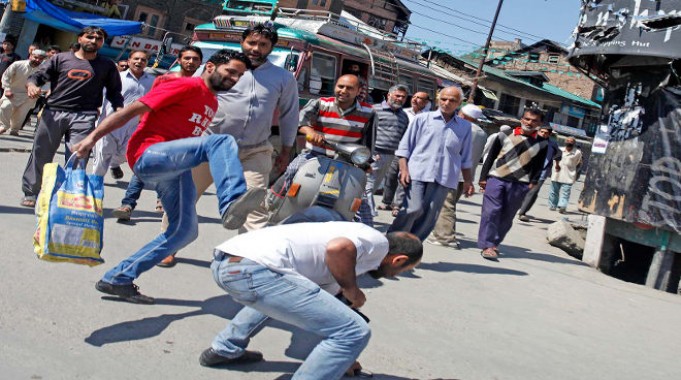Leading journalist Javid Malik was beaten up in the Valley. Journalists protested. Good.
But why have other violent incidents gone unmarked asks IRFAN QURAISHI. Pix: Protest at Lal Chowk, Srinagar, June 23.

The fact that the alleged beating of a journalist in Srinagar by the security guards of state Agriculture Minister Ghulam Nabi Lone on June 22 made the headlines was surprising. The media fraternity in Kashmir have never been too bothered in the past by journalists getting thrashed. What was different this time? Was it some newfound unity or was it a case of selective indignation?
The incident occurred when Lone’s security guards became violent with senior journalist Javid Malik of the leading English daily, Greater Kashmir, during a fracas over his delay in giving way to the cavalcade. “As they were leaving, one of the guards passed lewd remarks at my wife. I chased the minister’s motorcade to bring it to his notice,” said Malik. The guards kept thrashing him despite his wife’s pleas.
Social media was full of condemnation and expressions of solidarity. Almost all the leading news agencies and newspapers, both national and local, gave prominent coverage to the incident. Undoubtedly, the use of force against a journalist is highly condemnable but I wonder why journalists experience solidarity and unity only when a prominent journalist is involved but not about others? Are the others ‘lesser’ journalists?
The way the media covered the Malik incident gives the impression that this was the first incident of its kind in the Valley when in fact scores of journalists have been brutally beaten, often by different security personnel, while doing their jobs without even a murmur of protest.
Even more surprising was the condemnation expressed by almost all mainstream political parties and even separatist groups, in addition to civil society organizations and trade unions. They all voiced their solidarity, demanded action against Malik’s assailants, and even staged a protest at the historic clock tower in the city centre, Lal Chowk.
But why was there silence when, on June 26, as journalists and photojournalists reached Old Srinagar’s Nowhatta area to cover the Friday protests, some men believed to be the “henchmen” of a political party, started blaming journalists for triggering chaos every Friday and beat up Kashmir Life’s Photo Chief, Bilal Bahadur and his colleagues?
Photojournalist Javed Dar said: “Never in my 15 years career as photojournalist, have I seen civilians laying their hands on journalists at Nowhatta. Those who pounced on us this Friday didn’t look like locals. They were standing in a separate group and were probably from some political party.”
There has been silence over other incidents too:
- On June 19, Eshan Peer, a photojournalist, was thrashed by the CRPF when he was taking pictures in Sopore.
- On March 27, Kurshid Qureshi was beaten to pulp by the security guards of the Sher-e-Kashmir Institute of Medical Sciences Soura when he urged a security guard to behave decently after he had found the guard beating an attendant at the hospital.
- On March, 26, 2013, photojournalist Muneebul Islam was beaten up by police while covering the protests in Anantnag over the death of a youth.
- On September 27, 2012, Azhar Qadri was allegedly assaulted by a police officer in Srinagar while covering a protest by nursing students at the Old Secretariat.
- On December 3, 2011, Shahid Tantray, a photojournalist, Umer Mehraj, a video-journalist, and two photojournalists Yawar Kabli and Showkat Shafi, were ruthlessly beaten by CRPF personnel and the police in the old quarter.
Barring the media houses they worked for and a brief condemnation from the Photojournalists Association, these journalists found themselves on their own, with the fraternity showing no solidarity or support. Unless journalists in the Valley treat all journalists with the same respect and concern, the ideal of unity will never be created. The reaction to what Malik had to endure was commendable but it must be extended to each and every journalist when such incidents happen.
Moral support from fellow-journalists is all the more essential for journalists working in the Valley where there are daily troubles to deal with and where, whenever there is unrest, journalists are accused of biased, insensitive or provocative reportage from all sides.
It is not easy to work as a journalist at the best of times but it is even harder in the Valley where people refuse to cooperate and tell the truth unless it is on condition of anonymity and where newspapers constantly run the risk of having government advertising withdrawn if their coverage is deemed to be too ‘pro-people’?
Journalists are damned by both sides – by the ruling dispensation if their reports are pro-people and by the people for being government ‘agents’ if they give the latter’s view. Of course, this shows, in a weird sort of way, that they must be doing something right if they are being attacked from all sides. But these working conditions and atmosphere do complicate the lives of journalists immeasurably. In order to deal with these extra pressures, they need to be united, as they have been over Malik’s mistreatment, but they need to demonstrate this unity every time a journalist is treated unlawfully, not just on selective occasions.
(Irfan Quraishi is Bureau Chief, Kashmir, for Day & Night News, a Chandigarh-based national news channel.)


Comments are closed.